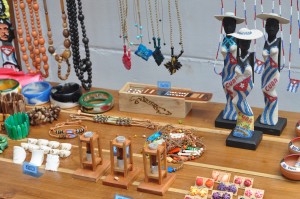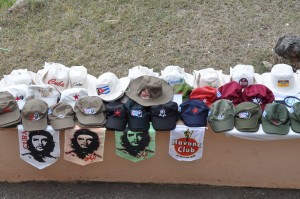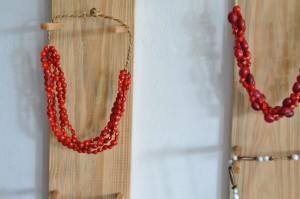Selling Cuba
April 19, 2012 by mamielke
A few days before our departure for Cuba, our professors devoted some class time to answering questions from students trying to figure out what to expect once on the ground in Cuba. Pretty quickly, the topic of money came up. I know that I was not the only student attempting to figure out how to budget my trip to Cuba. The political situation of Cuba complicates the matter, as once we were in Cuba; there would be no way to access further resources in the United States. American credit cards were not an option; we would have to bring cash.
One of the details revealed in this session was that Cuba generally did not have a huge handmade craft market as Mexico, or other Latin American countries typically do. I remember being somewhat surprised by this, but then thinking, “It’s Cuba.”
On the ground, it was a totally different story. Even walking from our hotel to Obispo Street, the stand owners hawking crafts to tourists practically jumped out at you. At first I was enchanted by the little trinkets, and the supposed differences in holdings among the markets, but I came to see that each stand held basically the same things as the stand before it.
One of the larger markets that we encountered fairly early on was the market at the Morro Fortress. After the Cañonazo ceremony, the tourists in the audience were practically herded into a winding alley that led to the exit of the colonial fortress. I did not see too many things in this market that were specifically linked to the fortress or the ceremony, just things under the banner of what Cuba wants their image to be. I was surprised that none of the stand owners seemed to be taking advantage of this exceedingly touristic endeavor; the cannon reenactment ceremony and the men dressed up in colonial garb seemed to be begging for it. Perhaps this image of Cuba was being marketed in a more institutionalized space that I didn’t notice, as opposed to the stands on the streets within the fortress’s walls. It made me wonder if these stand owners tended to move around a lot, or if they generally stayed in the same places. I also wondered if the choice of moving or staying was a privilege afforded to these workers.
This might have been the first time I saw the miniature antique cars made out of Cristal or Bucanero beer cans. Key chains with the face of Che were a common staple of this market very close to where Che Guevara’s office of the revolution still stands. There was also a small book stand, where the owner immediately pointed out the few books that were in English. Some of the prettier objects were the beautifully crafted leather shoes or purses. These were some of the most expensive purchases, but they seemed to be pretty sturdy and well-made.
Another market option was the flea markets in Trinidad. I only made it to one, which I was told was the smaller of the two markets. Here, jewelry and clothing seemed to be more prominent than in other markets I had seen. This market also had relatively more expensive things. At the Morro Fortress, I had purchased a 1 CUC necklace for my mother. In Trinidad, a ring caught my eye. I went to inquire about the price, and was surprised to hear that the rings were 5 CUC. In a place where 5 CUC could get you a good lunch and a drink, even for me, this seemed a bit extravagant. Besides this emphasis on jewelry and clothing, many of the same images of souvenirs came before my eyes.
The biggest example of this souvenir selling was the large warehouse full of stands in Havana Vieja. When I entered this place, art was the thing that stood out to me immediately. From very large paintings to miniscule tiles, the ability to take home a piece of “authentic” Cuban art was paraded in front of those with the ability to pay the price. I know that some of the prices were around the 100 CUC arena.
Beyond this, there must have been hundreds of stalls devoted to selling T-shirts, magnets, cups, cigar boxes, postcards, dresses, earrings, necklaces, wood carvings, and etcetera. Many stands, which only contained small nick-nacks, were devoted to the very American tourist tradition of bringing back tokens of your vacation to those who were not able to travel with you. Many stands were able to specialize in only selling T-Shirts, some only Che shirts, others devoted to images of Cuban alcoholic beverages. When I purchased a shirt, which was supposed to be 8 CUC, I bargained it down to 6 CUC. When I say “bargained” I am giving myself a little more credit than due, I simply asked if I could pay 6 instead of 8, and the nice shopkeeper obliged. Later I heard from another shopkeeper that generally the stand occupiers do not allow for bartering as many of the stands only stay afloat because the owners are able to collude on prices. This makes sense in a place where everyone seemed to be selling the same things, and I wondered about the socioeconomic status of those who worked these booths. There seemed to be so many tourists there, with so many CUCS, that I would understand if this was a more lucrative profession than going the typical state route. In Cuba, where education is allegedly free, having advanced degrees does not guarantee you much in the country. It seemed everywhere we went we encountered waitresses, bartenders, and other hospitality workers that were highly trained in a field of science or broader academia.
On my way out, I decided to go for the “8 for 4 CUC” magnet special. While carefully selecting my magnets, the shopkeeper asked where I was from. With my very rusty Spanish, I told him “Los Estados Unidos” and his reaction was similar to many I had received before. He immediately asked if I had been staying in Varadero. I almost felt guilty that I had to say yes, but then qualified my statement by saying that we had traveled pretty extensively around the island. After this encounter, I recognized that many within the Market seemed to have just returned from beach resorts, perhaps making some last minute purchases before heading to the Jose Martí Airport.
Even after returning to the United States, I was still very curious about the tourist markets within Cuba. As I unwrapped the few little gifts that I had bought for my parents, I saw that the coffee cups I had purchased were wrapped in some crumpled sheets of paper. On first glance, I thought these sheets were some sort of government mandated charts in order to keep track of their purchases and sales. However, on closer inspection, I saw they were charts from the Ministerio De La Industria Basica, from 2006. It seemed to be a chemical engineer’s very detailed record of all the checks that he or she had made that day, and the invoices he or she had received. Perhaps the woman selling the “2 for 4 CUC” coffee cups was once a chemical engineer who had found these tourist markets to be more lucrative.
(Photos by Baynard Bailey and Lisa Paravisini-Gebert)
Leave a Reply
You must be logged in to post a comment.


